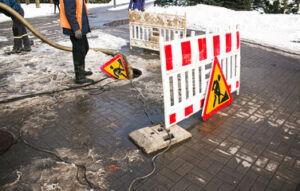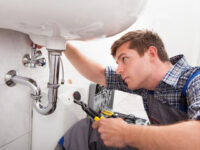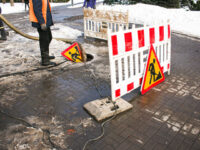Trenchless Sewer Repair
Trenchless sewer repair is a fast, efficient way to fix your damaged sewer line without digging large trenches across your property. It is also less expensive than traditional excavation.
The most common trenchless sewer repair methods include pipe lining and pipe bursting. The pipe lining method involves inserting a flexible sleeve coated with resin into your existing pipeline, which then hardens to create a new structural pipe inside the old one. For professional assistance, call Plumber Montgomery TX.
Pipe lining is one of the most popular trenchless sewer repair techniques. With this method, technicians clean out the pipes before inserting a liner that covers the walls of the damaged pipe. This results in a pipe-within-a-pipe that is tough, durable, and can last for years. In addition, this process is less expensive than traditional pipe replacement and requires minimal digging.
This is a great solution for many homeowners who have issues with their drains that are caused by roots or broken lines. However, it may not be appropriate for problems such as collapsed pipes or severe damage. This method can also be more difficult to install in older homes with curved pipes.
The main reason that this is a great option for most homeowners is because it is much less expensive than replacing the entire pipe. In addition, it requires very little disruption to the property and can be completed in a matter of hours. This means that you will not have to deal with loud construction equipment and construction crews in your yard for days.
There are two types of pipe lining that can be used to perform a trenchless sewer repair. Spray lining and brush coating are both non-invasive processes that can be performed on pipes of all sizes. These methods work by applying a coat of epoxy to the surface of your existing pipes. This will help to prevent leaks, stop water and sewage flow, and stop root penetration. These processes can be completed in a few hours and are suitable for most homes.
Another type of pipe lining is known as “cured in place pipe” (CIPP). With this method, your plumber will cut an access hole into the old, damaged line and then saturate a felt tube with epoxy. Once the epoxy is saturated, it is blown or pulled into your existing pipe and inflated. This creates a pipe within a pipe and results in a water-tight seal that is strong enough to last for decades.
This method does slightly reduce the size of your pipe, but it is not a big enough difference to affect most homes’ drainage needs. Additionally, this type of repair is also very cost-effective and can be completed in a very short amount of time.
Pipe Bursting
In some cases, you’ll need to replace your old, broken sewer lines. Old pipes are more likely to crack, break, and become clogged with debris or tree roots. When this happens, you’ll need to have your sewer line replaced ASAP to prevent waste backups and other issues from occurring in your home. Trenchless sewer pipe replacement is a great way to do this without disrupting the ground around your property.
To use the trenchless pipe bursting method, your plumber will dig two small holes at either end of the sewer run that needs to be replaced. A cable is fed through these holes, and a cone-shaped “bursting head” is hydraulically pulled through the old pipe. This head breaks the old pipe apart as it goes through and simultaneously pulls in a new seamless, heat-fused HDPE pipe behind it. The new pipe is then heat-welded above ground to ensure it will last for decades to come.
This method is ideal for replacing sewer and water lines in paved or landscaped areas, near bodies of water, or in Delaware’s environmentally sensitive soil conditions where digging up pipes may be a problem. It’s also much less expensive than traditional excavation and pipe-laying methods. In fact, you can expect to save up to 40 percent with this method.
While both CIPP lining and pipe bursting offer benefits for homeowners who need to repair or replace their sewer pipes, the latter is more comprehensive than the former. Unlike CIPP, which can mask whatever quirks or issues your pipes have, pipe bursting results in brand-new pipes that are ready to go.
Like all trenchless plumbing methods, pipe bursting isn’t a good fit for every situation. For example, this technique cannot be used on old cast iron or clay pipes that are too damaged to use or break apart during the bursting process. It is also not an option if you have a lot of sand or other fill in your soil, which would make it difficult for the bursting head to push through. You’ll also need to be prepared to spend more upfront than you would with a traditional excavation and pipe-laying job.
Pipe Relining
Pipe relining is a less-invasive and more cost-effective option for fixing a damaged sewer line. First, Drain Brain, LLC, runs a sewer scope through the line to find where the problem is and what caused it (such as tree roots or ground movement). Then we use sewer pipe-clearing technology to remove any blockages. Once the pipes are clean, we blow in or pull in a new flexible liner that’s coated with resin and created to fit inside the existing pipe. It’s a “pipe within a pipe” called Cured-In-Place Pipe (CIPP).
With this trenchless method, no excavation is necessary. The lining is placed over the broken sewer pipe and inflated so it can settle in place, forming the shape of a new, stronger, more efficient pipe. The lining is typically made from HDPE, an environmentally safe material that lasts for over 100 years.
Unlike traditional sewer repair methods, the relining process takes only one to three days and leaves minimal surface disturbances on your property. This means that you’ll be able to get back to your normal routine more quickly, and your landscaping will be preserved.
Conventional sewer line repair involves massive digging throughout your entire yard in order to replace or repair the faulty pipe. But with trenchless sewer repair, only the affected area of your yard is dug. This means that your flower beds, driveway, and sidewalk are left undisturbed.
The relining process can be done from an access point in your front yard, backyard, or alleyway and usually doesn’t require a permit. It’s also a safer procedure for plumbers, as it eliminates the need to dig holes in your yard that may be exposed to uncontrolled construction debris or water.
In the end, you’ll have a stronger, more efficient sewer line that can withstand even the most destructive forces of nature. This helps to protect the environment, your home, and its surroundings, and can even add value to your home. Plus, it’s much more affordable than traditional repairs or replacements, which can cost thousands of dollars and take months to complete. That’s the true definition of a win-win situation for everybody.
Pipe Replacement
If you have a severely damaged sewer line, it may need to be replaced. Fortunately, traditional sewer pipe replacement is not the only option; trenchless methods are now available to avoid the mess and disruption of digging. Trenchless repair is just as effective as conventional work and can be done faster and at a fraction of the cost.
If your sewer line needs to be replaced, Jones Services can use a method called pipe bursting or pipe lining to do the job without having to dig large trenches in front of your home. Both techniques are quick, relatively inexpensive, and can usually be completed in a day or less. The new pipes used in trenchless sewer line replacement are also designed to last decades.
Trenchless sewer pipe replacement uses a cable attached to a head that is pulled through the existing pipe, pushing against it and pulling a new pipe in place. The resulting new pipe is the same diameter as the old one and will allow for the same amount of flow. Pipe bursting can be used to replace a short section of piping or an entire length. This method can be particularly useful when the damage to the existing pipe is limited to a small area near your house.
Unlike traditional trenching methods, trenchless sewer pipe replacement requires only two access holes: one where your sewer line enters your home and the other where it connects to the sewer main. This significantly reduces the time required to complete the work and minimizes the amount of debris that has to be removed from your property afterwards.
The lining method for replacing your sewer line involves inserting an epoxy-soaked liner into your existing pipe. Once it has been cured, your new pipe is as good as new. This method is also preferred because it doesn’t harm any trees that may be in the area and can even be used to reline sections of your sewer line that have been damaged by tree roots.
When you hire a skilled plumbing specialist to repair your sewer lines, they will know the best trenchless method for the job and how to get it done quickly and efficiently. Trenchless repairs are far less expensive than traditional methods and can save you the cost of having to replace landscaping, driveways, sidewalks, and other structures around your home.




